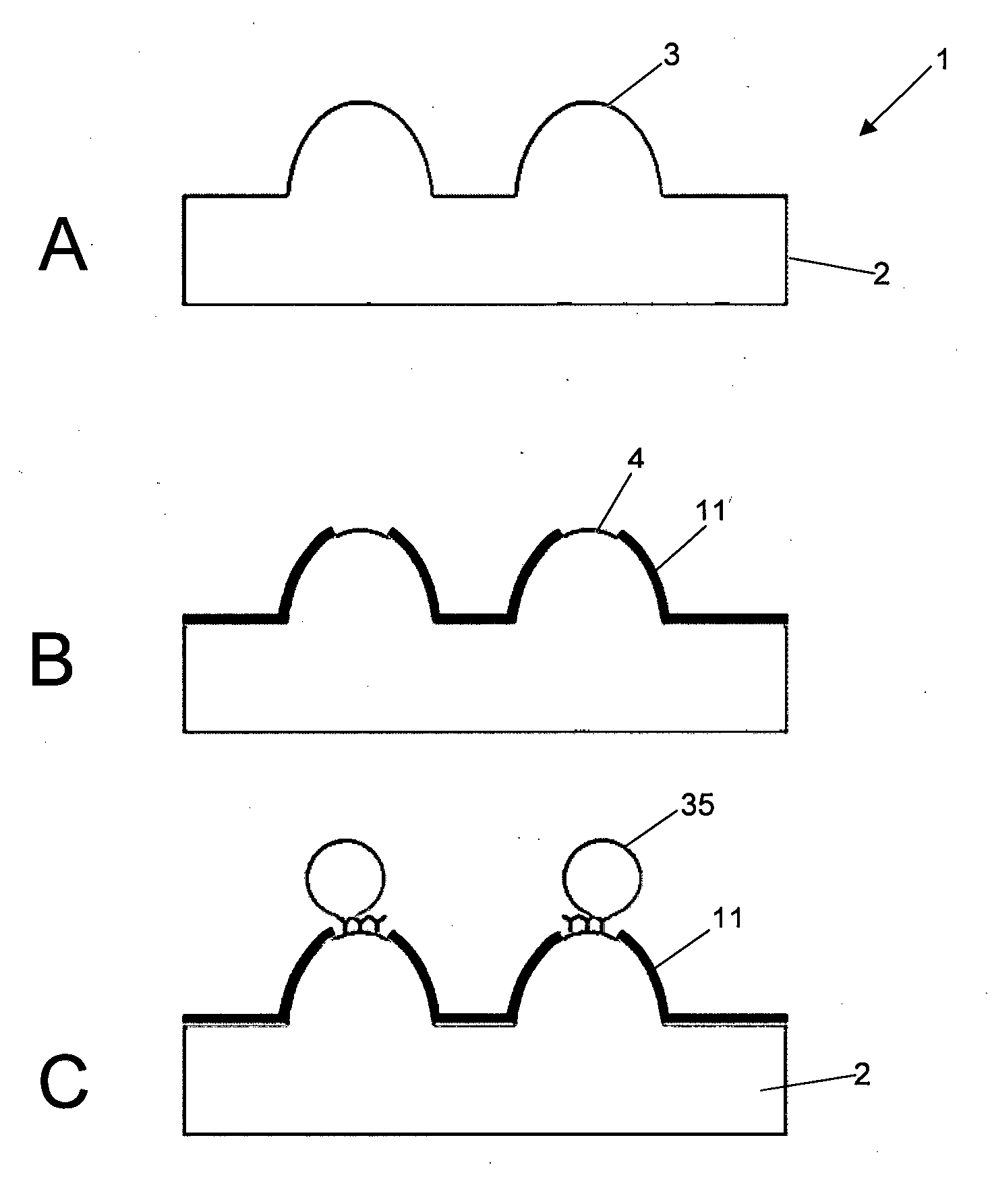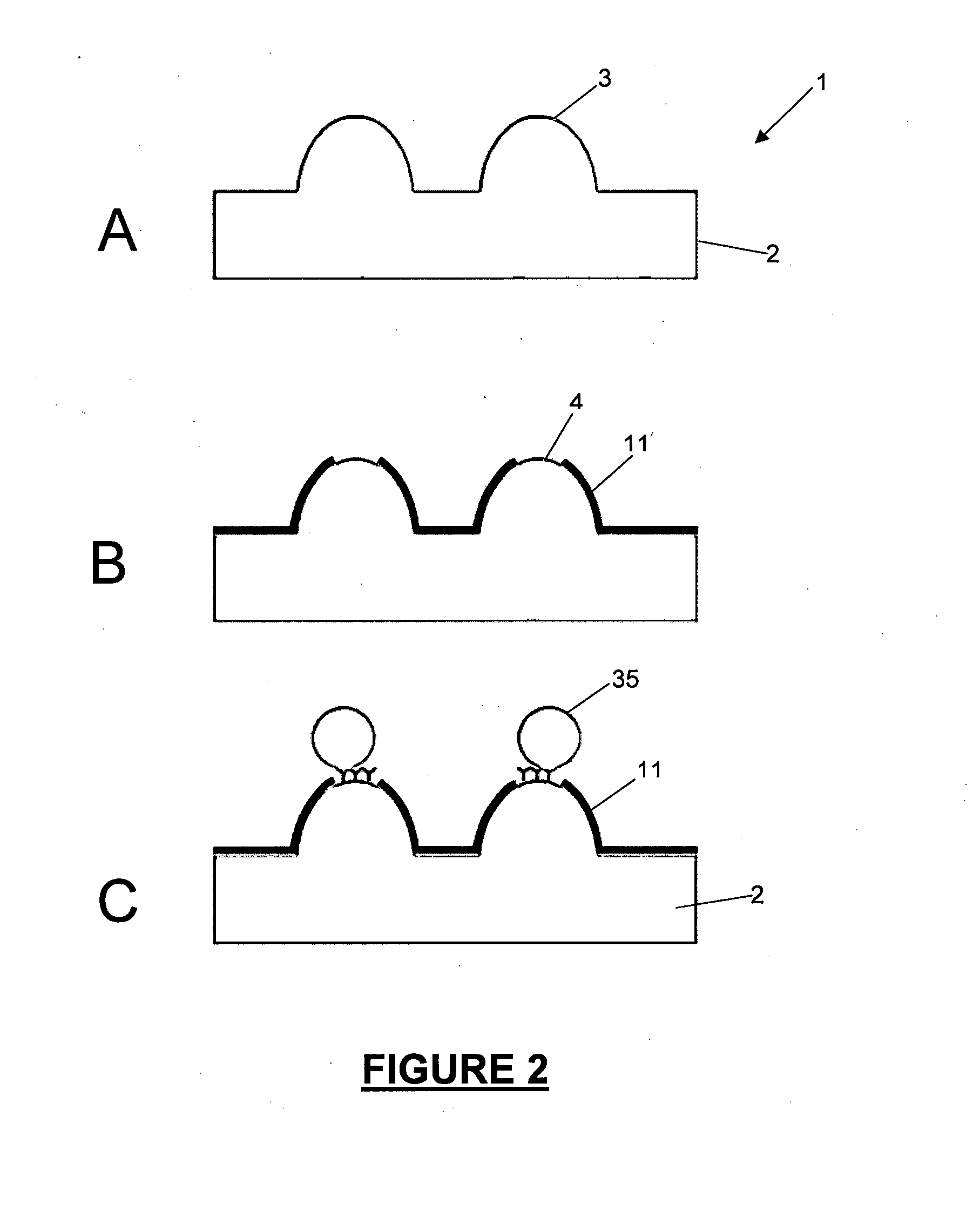Microarrays
a microarray and microstructure technology, applied in combinational chemistry, chemical libraries, libraries, etc., can solve the problems of preventing on-site testing and accurate detection beyond certain sensitivity limits, reading instruments and/or sensing processes, and considerable training and expertise are often required
- Summary
- Abstract
- Description
- Claims
- Application Information
AI Technical Summary
Problems solved by technology
Method used
Image
Examples
example 1
Immobilisation of Bead Conjugates on the Surface of a Three-Dimensional Microarray
[0353]Following the process shown in the diagrammatic depiction in FIG. 5, and with reference to FIG. 11, the following experiment was carried out using coloured bead conjugates as the target analyte:
[0354]A three-dimensional microcone array 20, manufactured from a PMMA polymer substrate and coated in gold 21 was employed (FIG. 11, (A)). The cone tips 22 measured 100 μm in diameter. Following removal of gold from the cone tips 22 by abrasion an —NH2 functional group was attached to the exposed PMMA polymer surface at the defined area formed by the exposed cone tips 22. Thus a defined fuctionalized area at exposed cone tips 22 is formed. This was achieved by exposing the surface of the microarray to 1 to 20% ethylenedamine in DMSO for 5 to 20 minutes. The surface was then washed with IPA and dried under N2 gas. The surface was then exposed to 2% GA in sodium carbonate buffer (pH 9.2) for two hours with ...
examples 2 and 3
Schemes 1 and 2 in the Examples below show schematic representations of the process described in Examples 2 and 3, respectively. Steps (1) to (4) of Scheme 1 are microarray preparation steps as discussed earlier and are applicable to both examples 2 and 3. A key for components A to G in both Schemes is provided in Scheme 1.
example 2
Sandwich Assay for Large Protein Molecules
[0355]Scheme 1, steps (5) to (7) show a sandwich assay for rat IgG. The three-dimensional microarray employed was 100 μm in diameter and was formed from PMMA substrates. After removing gold from the cone tips and introducing a —NH2 functional group to each cone tip, the cone tips were further reacted with glutaraldehyde in PBS buffer (pH 7.4) to bind a —CHO functional group to the functionalized cone tips. A solution of commercial anti-rat IgG (secondary antibody) (RS128, Sigma) in PBS was then reacted with the cone tips overnight to immobilize the anti-rat IgG onto the tips. After washing the microarray with PBS, a solution of commercial proteins (Rat IgG) (P1922, Sigma) in PBS and in various concentrations, are reacted with the anti-rat IgG on the tips at 40° C. for 1 hour. Finally, after a PBS wash of the microarray, a suspension of anti-rat IgG coated microparticles was further reacted with the substrates at 40° C. for 1 hour to attach t...
PUM
| Property | Measurement | Unit |
|---|---|---|
| thickness | aaaaa | aaaaa |
| thickness | aaaaa | aaaaa |
| size | aaaaa | aaaaa |
Abstract
Description
Claims
Application Information
 Login to view more
Login to view more - R&D Engineer
- R&D Manager
- IP Professional
- Industry Leading Data Capabilities
- Powerful AI technology
- Patent DNA Extraction
Browse by: Latest US Patents, China's latest patents, Technical Efficacy Thesaurus, Application Domain, Technology Topic.
© 2024 PatSnap. All rights reserved.Legal|Privacy policy|Modern Slavery Act Transparency Statement|Sitemap



